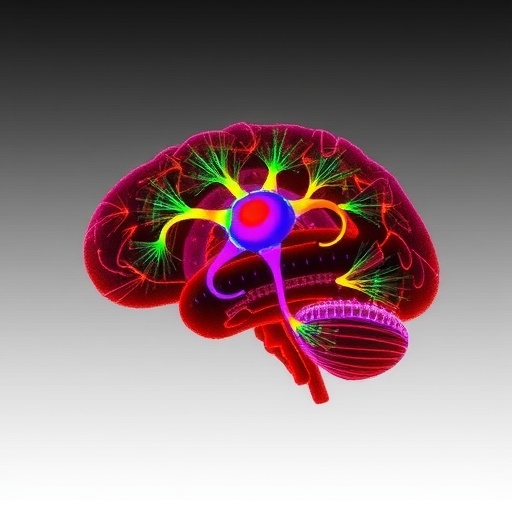In a remarkable advancement that blurs the lines between neuroscience and engineering, researchers have introduced a groundbreaking implantable complementary metal–oxide–semiconductor (CMOS) fluorescence imager capable of achieving single-neuron resolution deep within the brain. Until now, optical imaging techniques have been narrowly focused on superficial brain regions due to significant challenges associated with light scattering in biological tissues. This innovative tool could change the landscape of neural imaging, providing unprecedented depth and clarity in brain research.
The foundational technology behind this advancement includes a high-resolution image sensor that utilizes a compact, post-processed design. Specifically, the device features a 512-pixel silicon image sensor compacted into a slim shank measuring just 4.1 mm in length and 120 μm in width. This compact architecture is paired with a collinear fiber optic system for illumination, allowing it to penetrate deeper brain tissues than ever before. By doing so, the researchers have not only enhanced the spatial resolution but also ensured minimal disruption to the surrounding brain structure—a significant improvement over previous optical imaging methods.
One of the most critical aspects of this device is its ability to record transient fluorescent signals at a rapid frame rate of 400 frames per second. This high temporal resolution is essential for capturing dynamic neuronal activities, particularly in populations of neurons expressing the genetically encoded calcium indicator GCaMP6s. The GCaMP6s protein is known for its effective capability to provide real-time insights into intracellular calcium dynamics, a crucial component of neuronal signaling. This alignment of advanced imaging technology with molecular biology offers researchers an invaluable window into the neuronal activity occurring deep within the brain.
In the past, techniques such as electrophysiological recordings often fell short in providing a comprehensive understanding of the dynamics within specific populations of neurons. While electrophysiology boasts excellent temporal resolution, it lacks the cell-type specificity that optical techniques can naturally provide. The new CMOS-based imager bridges this gap by enabling the study of deep brain circuits without compromising the fidelity of the recordings, thereby making it a versatile tool for neuroscientific research.
One of the significant hurdles for traditional optical imaging methods has been their limited depth of field due to the scattering of light within brain tissues. The scattering phenomenon not only blurs the imaging but also restricts the fields of view available to researchers. Historically, passive optical conduits like graded-index lenses have allowed access to deeper brain regions, but they come with constraints on resolution and a tendency to create significant lesions along the insertion route. This new development eliminates many of those drawbacks, presenting a less invasive option that spares surrounding brain tissue while allowing for detailed observation.
Researchers expect the applications of this new imaging system to span various domains within neuroscience, from basic research to clinical applications. For instance, studying neurological diseases such as epilepsy, Alzheimer’s disease, and Parkinson’s disease could benefit significantly from the insights garnered through this device. As researchers continue to gain a deeper understanding of the intricate networks within the brain, the implications for therapeutic interventions may become clearer, offering hope to those affected by debilitating neurological conditions.
Moreover, the ability to access deeper brain structures opens the door to exploring previously enigmatic regions implicated in a variety of cognitive and behavioral processes. This includes, but is not limited to, regions responsible for memory, decision-making, and emotional regulation. The high-resolution imaging capabilities enable scientists to dissect complex neural circuits and their functional roles in behavior, potentially unearthing new therapeutic targets.
In addition to offering deep-brain access without major disruptions, this implantable technology also holds promise for in vivo experiments where real-time monitoring of neuronal activity is critical. For researchers investigating the effects of pharmacological interventions or behavioral tasks, the immediate feedback provided by this imaging system could yield insights at a pace that surpasses traditional methods.
As with any new technology, rigorous validation and further refinements will be essential. Future studies will need to rigorously assess both the efficacy and safety of the CMOS imager in various experimental contexts. Additionally, researchers will likely explore the integration of other modalities, such as optogenetics, which could enhance the functionality of the imaging system.
Moreover, ethical considerations surrounding the use of implantable devices in animal and human research will come into play. Transparency in reporting findings and ensuring the humane treatment of subjects will be paramount as this technology moves forward in academic and clinical settings. The proliferation of such advanced imaging methodologies necessitates a thoughtful discourse about the implications for both research and clinical practice.
In summary, the development of this implantable CMOS deep-brain fluorescence imager represents a major stride forward in neuroimaging technology. By marrying advanced optics with sophisticated silicon sensor technology, researchers have created a device that not only enhances our understanding of neural networks but also paves the way for new discoveries that could transform our approach to treating neurological disorders. As scientists continue to explore the depths of the brain with this innovative system, we are likely on the brink of groundbreaking revelations that could reshape our understanding of the mind itself.
The journey ahead promises to be an exciting one, with ongoing research poised to refine and expand the capabilities of this imaging technology. Bursting with potential, the implications of this breakthrough extend far beyond fundamental research, potentially revolutionizing our approach to understanding and treating complex brain-related conditions in the years to come.
Subject of Research: Implantable CMOS Deep-Brain Fluorescence Imager
Article Title: An implantable CMOS deep-brain fluorescence imager with single-neuron resolution
Article References:
Yilmaz, S., Choi, J., Uguz, I. et al. An implantable CMOS deep-brain fluorescence imager with single-neuron resolution.
Nat Electron (2025). https://doi.org/10.1038/s41928-025-01487-y
Image Credits: AI Generated
DOI: 10.1038/s41928-025-01487-y
Keywords: CMOS, deep-brain imaging, fluorescence, single-neuron resolution, GCaMP6s, neuroscience, neural circuits, neuroimaging, advanced optics, implantable devices.




